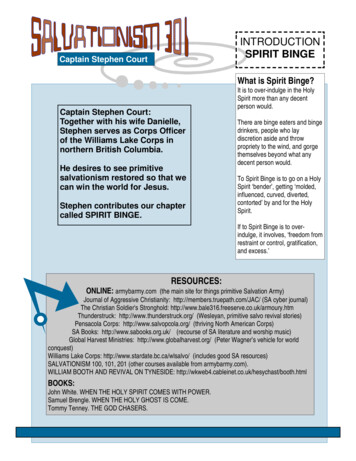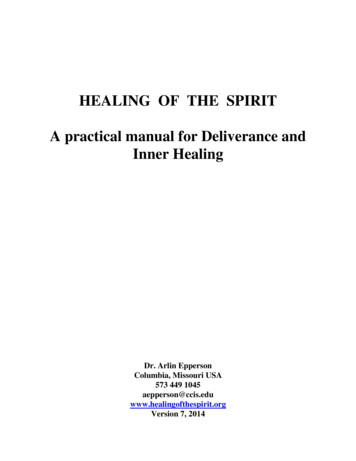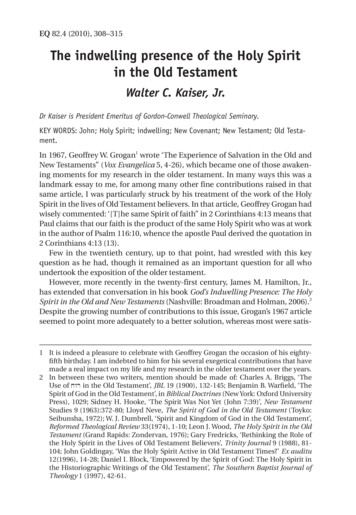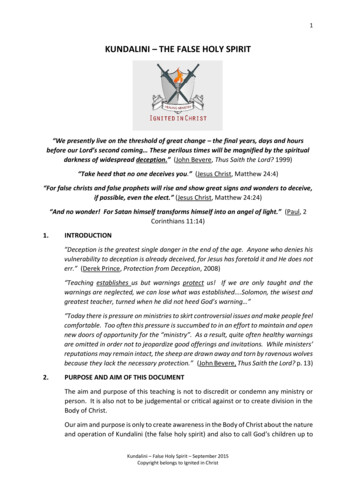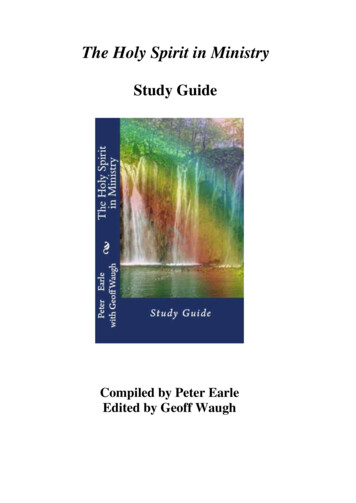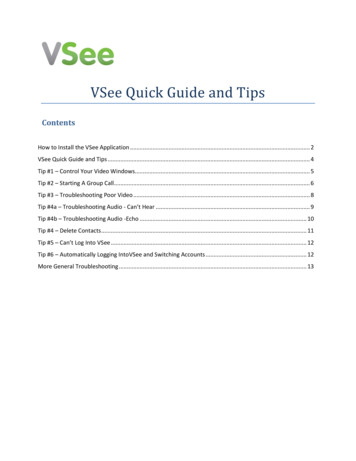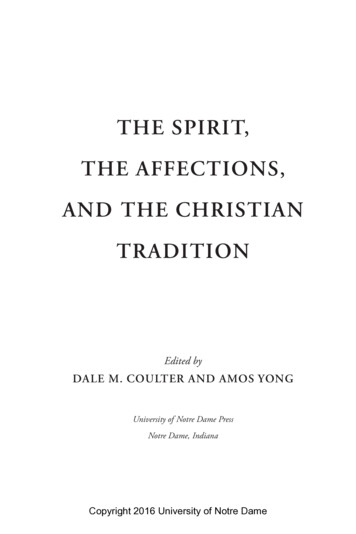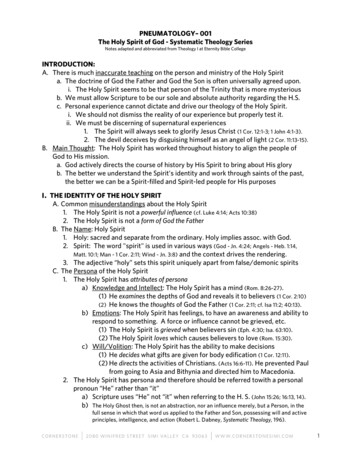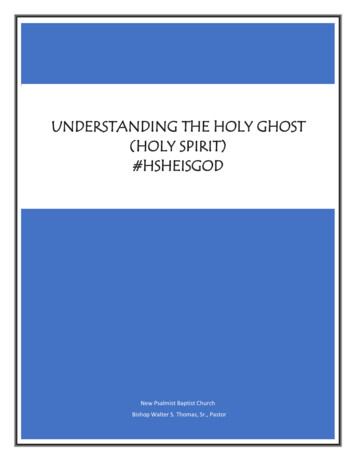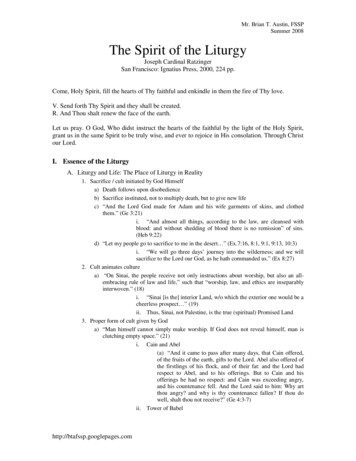
Transcription
Mr. Brian T. Austin, FSSPSummer 2008The Spirit of the LiturgyJoseph Cardinal RatzingerSan Francisco: Ignatius Press, 2000, 224 pp.Come, Holy Spirit, fill the hearts of Thy faithful and enkindle in them the fire of Thy love.V. Send forth Thy Spirit and they shall be created.R. And Thou shalt renew the face of the earth.Let us pray. O God, Who didst instruct the hearts of the faithful by the light of the Holy Spirit,grant us in the same Spirit to be truly wise, and ever to rejoice in His consolation. Through Christour Lord.I. Essence of the LiturgyA. Liturgy and Life: The Place of Liturgy in Reality1. Sacrifice / cult initiated by God Himselfa) Death follows upon disobedienceb) Sacrifice instituted, not to multiply death, but to give new lifec) “And the Lord God made for Adam and his wife garments of skins, and clothedthem.” (Ge 3:21)i. “And almost all things, according to the law, are cleansed withblood: and without shedding of blood there is no remission” of sins.(Heb 9:22)d) “Let my people go to sacrifice to me in the desert ” (Ex.7:16, 8:1, 9:1, 9:13, 10:3)i. “We will go three days’ journey into the wilderness; and we willsacrifice to the Lord our God, as he hath commanded us.” (Ex 8:27)2. Cult animates culturea) “On Sinai, the people receive not only instructions about worship, but also an allembracing rule of law and life,” such that “worship, law, and ethics are inseparablyinterwoven.” (18)i. “Sinai [is the] interior Land, w/o which the exterior one would be acheerless prospect ” (19)ii. Thus, Sinai, not Palestine, is the true (spiritual) Promised Land3. Proper form of cult given by Goda) “Man himself cannot simply make worship. If God does not reveal himself, man isclutching empty space.” (21)i. Cain and Abel(a) “And it came to pass after many days, that Cain offered,of the fruits of the earth, gifts to the Lord. Abel also offered ofthe firstlings of his flock, and of their fat: and the Lord hadrespect to Abel, and to his offerings. But to Cain and hisofferings he had no respect: and Cain was exceeding angry,and his countenance fell. And the Lord said to him: Why artthou angry? and why is thy countenance fallen? If thou dowell, shalt thou not receive?” (Ge 4:3-7)ii. Tower of Babelhttp://btafssp.googlepages.com
(b) “And they said: Come, let us make a city and a tower, thetop whereof may reach to heaven; and let us make our namefamous before we be scattered abroad into all lands.” (Ge11:4)iii. Strange Fire(a) “And Moses and Aaron went into the tabernacle of thetestimony, and afterwards came forth and blessed the people.And the glory of the Lord appeared to all the multitude. And,behold, a fire, coming forth from the Lord, devoured theholocaust, and the fat that was upon the altar: which when themultitude saw, they praised the Lord, falling on their faces.And Nadab and Abiu, the sons of Aaron, taking their censers,put fire therein, and incense on it, offering before the Lordstrange fire: which was not commanded them. And firecoming out from the Lord destroyed them: and they diedbefore the Lord.” (Le 9:23-10:2)iv. Golden Calf(a) “Worship is no longer a going up to God, but drawingGod down into one’s own world The narrative of the goldencalf is a warning about any kind of self-initiated and selfseeking worship.” (22-23)B. Liturgy—Cosmos—History1. Universe created for the right worship of the Lorda) Seven Days of Creation moves towards the Sabbath, resting with the Lordb) Parallel creation account in the building of the Tabernaclei. Seven times it says “Moses did as the Lord had commanded him”ii. And then, “The cloud covered the tabernacle of the testimony, andthe glory of the Lord filled it.” (Ex 40:32)iii. Itself points towards the future Temple; Incarnation (Temple Madewithout Hands); Heavenly Jerusalem2. But what is this worship?a) We have already seen that the essence of worship is sacrifice. But this merely pushesthe question back further. What is the essence of sacrifice?i. Some have suggested that the essence of sacrifice is destruction;that the act of destruction symbolizes a total giving to God.ii. “True sacrifice consists—according to the Fathers, in fidelity tobiblical thought—in [a transforming] union of man and creation withGod. [This] belonging to God has nothing to do with destruction ornon-being: it is rather a way of being.” (28)iii. The grain of wheat surely falls to the ground and dies, but it is notdestroyed simply; rather, it is transformed, becoming (ultimately)bread. (cf. Jn. 12:24; cf. Ratzinger, Mary: The Church at the Source,ch. 1)3. Who / what is transformed via this worship?a) This transformation is the destiny not only of man, but of all of creation. St.Augustine says that the “true sacrifice is the City of God, that is, a love-transformedmankind, the divinization of creation and the surrender of all things to God: God all inall (cf. 1 Cor. 15.28). That is the purpose of the world. That is the essence ofsacrifice and worship,” (28) which must draw not only man, but also “the whole ofreality into communion with God” (27).-2-
i. “For we know that every creature groaneth and travaileth in pain,even till now. And not only it, but ourselves also, who have thefirstfruits of the Spirit: even we ourselves groan within ourselves,waiting for the adoption of the sons of God, the redemption of ourbody.” (Ro 8:22-23)ii. “And when all things shall be subdued unto him, then the Son alsoHimself shall be subject unto Him that put all things under him, thatGod may be all in all.” (1Co 15:28)iii. Cf. St. John the Divine’s mystical vision of the HeavenlyJerusalem.iv. Cf. Priest’s Thanksgiving after Mass—Canticle of the ThreeChildren (Dan.)C. From Old Testament to New: Biblical Determinations of the Christian Liturgy1. Shadow Image Reality2. Lamb of Abraham’s Sacrifice (Ge 22)a) “The True Lamb comes from God, and for that very reason is not a replacement,but a true representative, in Whom we ourselves are taken to God.” (38).3. Lamb of the Passover (Ex 12)a) Firstborn maleb) Spotlessc) Blood on crossed postsd) Eat the flesh of the lamb along w/ unleavened breade) Holocaustf) Octave celebrationg) Asperges me hyssopo (12:22)h) Haec est nox (12:42) of the Easter Exsultet4. Lamb in Tabernacle and Temple worship (Ex 25)a) “Look, and make it according to the pattern that was shewn thee in the mount.” (Ex25:40)b) Again, “this means that the earthly temple was only a replica, not the true Temple. Itwas an image and likeness, which pointed beyond itself.” (41)i. “And Samuel said: Doth the Lord desire holocausts and victims,and not rather that the voice of the Lord should be obeyed? Forobedience is better than sacrifices: and to hearken rather than to offerthe fat of rams.” (1Sa 15:22)ii. “For I desired mercy, and not sacrifice: and the knowledge of Godmore than holocausts.” (Hosea 6:6)5. Lamb of Goda) “The next day, John saw Jesus coming to him; and he saith: Behold the Lamb of God.Behold him who taketh away the sin of the world.” (Joh 1:29 Douay)b) “Jesus answered and said to them: Destroy this temple; and in three days I will raiseit up.” (Joh 2:19)i. “With His Resurrection, the new Temple will begin: the livingbody of Jesus Christ, which will now stand in the sight of God and bethe place of all worship. Into this body he incorporates men. It is thetabernacle that no human hands have made, the place of true worship ofGod, which casts out the shadow and replaces it with reality.” (43)ii. “Interpreted at its deepest level, the prophecy of the Resurrection isalso a prophecy of the Eucharist. The body of Christ is sacrificed, and-3-
precisely as sacrificed is living. This is the mystery made known in theMass. Christ communicates himself to us and thus brings us into a realbond with the living God.” (43)iii. This is symbolically expressed in “the torn curtain of the temple,[which is] the curtain torn between the world and the countenance ofGod. In the pierced heart of the Crucified, God’s own heart is openedup—here we see who God is and what He is like. Heaven is no longerlocked up. God has stepped out of his hiddenness.” (47-8)iv. “Christian worship regards the destruction of the temple inJerusalem as final and as theologically necessary. Its place has beentaken by the universal Temple of the risen Christ, whose outstretchedarms on the Cross span the world, in order to draw all men into theembrace of eternal love.” (48)6. Lamb of the Apocalypse / Eschatona) “The Apocalypse presents this sacrificed Lamb, who lives as sacrificed, as the centerof the heavenly liturgy; a liturgy that, through Christ’s Sacrifice, is now present in themidst of the world” (38).i. “I am Alpha and Omega, the First and the Last, the Beginning andthe End. Blessed are they that wash their robes in the blood of theLamb: that they may have a right to the tree of life and may enter in bythe gates into the city .And he that thirsteth, let him come. And hethat will, let him take the water of life, freely He that givethtestimony of these things, saith: Surely, I come quickly: Amen. Come,Lord Jesus. The grace of our Lord Jesus Christ be with you all. Amen.”the world.” (Re 13:8)ii. “And I saw no temple therein. For the Lord God Almighty is thetemple thereof, and the Lamb. And the city hath no need of the sun, norof the moon, to shine in it. For the glory of God hath enlightened it: andthe Lamb is the lamp thereof And the gates thereof shall not be shutby day: for there shall be no night there.” (Re 21:22-25)iii. “And he shewed me a river of water of life, clear as crystal,proceeding from the throne of God and of the Lamb. In the midst of thestreet thereof, and on both sides of the river, was the tree of life,bearing twelve fruits, yielding its fruits every month: the leaves of thetree for the healing of the nations.” (Re 22:1-2)iv. “I am Alpha and Omega, the First and the Last, the Beginning andthe End. Blessed are they that wash their robes in the blood of theLamb: that they may have a right to the tree of life and may enter in bythe gates into the city .And he that thirsteth, let him come. And hethat will, let him take the water of life, freely He that givethtestimony of these things, saith: Surely, I come quickly: Amen. Come,Lord Jesus. The grace of our Lord Jesus Christ be with you all. Amen.”(Re 22:13-21)b) The “already” and “not yet” of Christian Liturgyi. “Christian liturgy is a liturgy of promise fulfilled, of aquest reaching its goal. But it remains a liturgy of hope. It, too, bearswithin it the mark of impermanence. The new Temple, not made byhuman hands, does exist, but it is also still under construction. Thegreat gesture of embrace emanating from the Crucified has not yetreached its goal; it has only just begun. Christian liturgy is liturgy onthe way, a liturgy of pilgrimage toward the transfiguration of the world,which will only take place when God is “all in all”” (50).-4-
(a) “For we know that every creature groaneth and travailethin pain, even till now. And not only it, but ourselves also, whohave the firstfruits of the Spirit: even we ourselves groanwithin ourselves, waiting for the adoption of the sons of God,the redemption of our body.” (Ro 8:22-23)(b) “And when all things shall be subdued unto him, then theSon also Himself shall be subject unto Him that put all thingsunder him, that God may be all in all.” (1Co 15:28)(c) “Who now rejoice in my sufferings for you and fill upthose things that are wanting of the sufferings of Christ, in myflesh, for his body, which is the church:” (Col 1:24)-5-
Mr. Brian T. Austin, FSSPSummer 2008II. Time and Space in the LiturgyA. Preliminary Questions1. How does the Liturgy transform time and space?a) The progressive unfolding of the Mystery of the Incarnationi. First Coming: Historical event of the Passion, Death, andResurrectionii. Second Coming: Vision of the Eschaton in the Apocalypseiii. In-between time of the Church on Earthb) This is not something which happens in a merely external fashion, ex opere operato.Rather, Christ’s “self-giving is meant to become mine, so that I become contemporarywith the Pasch of Christ and assimilated unto God. [M]artyrdom [is] the most extremeactualization of the Christian’s being a contemporary with Christ, of being unitedwith Him. [Indeed, the aim of the liturgy], as St. Paul says is that “our bodies” (thatis, our bodily existence on earth) become “a living sacrifice”, united to the Sacrificeof Christ (cf. Rom 12:1).” (58)i. “Now you are the body of Christ and members of member.” (1Co12:27)ii. “Because we are members of him, body, of his flesh and of hisbones.” (Eph 5:30)B. Sacred Places—Significance of Church Architecture1. Points of Continuity with the Synagoguea) Orientationi. All synagogues oriented towards the temple in Jerusalemb) Focal Pointi. Everyone looks “toward the Ark of the Covenant, or, rather, theshrine of the Torah, which represents the lost Ark.” (64)(a) Curtain tabernacle veil(b) Seven lights of the menorah Sanctuary lampsc) Divinely elected mediatori. Seat of Moses (Mt 23:2)(a) where the rabbi “makes present the Word that Godaddressed and addresses to Israel.” (64)2. The Christian churcha) Orientationi. Oriented as well—but towards the East, the Rising Sun, symbol ofthe Risen Christii. Of Apostolic traditioniii. “This turning toward the east also signifies that cosmos and savinghistory belong together. The cosmos is praying with us. It, too, iswaiting for redemption.” (70)(b) “For we know that every creature groaneth and travailethin pain, even till now. And not only it, but ourselves also, whohave the firstfruits of the Spirit: even we ourselves groanwithin ourselves, waiting for the adoption of the sons of God,the redemption of our body.” (Ro 8:22-23)b) Focal Point – the Christian Altarhttp://btafssp.googlepages.com
i. “For the altar of the Holy Church is Christ Himself as St. Johngave witness in the Book of the Apocalypse after seeing a golden altar,upon which and through which the offerings of the faithful werebrought to God the Father.” (Pontificale Romanum, Ordination of aSubdeacon)(a) Five crosses cut into it(b) anointed with sacred chrism (chrismated; christus /messhiah)(c) Wrapped in three sacred linen cloths(d) Kissed and incensed many times during the SacredLiturgyii. “The altar signifies the entry of him who is the Orient into theassembled community and the going out of the community from theprison of this world through the curtain now torn open, a participationin the Pasch, the “passing over” from the world to God, which Christhas opened up.” (70)(a) Point of Contact – Deus absconditus (Isaiah) becomesEmmanuel, God with us.iii. Thus, “it enables us to become the contemporaries of the Sacrificeof the Logos, [and] brings heaven into the community assembled onearth, or rather it takes that community beyond itself into thecommunion of saints of all times and places.” (71)(a) “Any soul that will ascend this mount in order to make ofitself an altar whereon it may offer to God the sacrifice of purelove and praise and pure reverence, must, before ascending tothe summit of the mount” be totally purified and transformed,in order that “its operation, which before was human, hasbecome Divine.” This transformation is complete in this lifeonly in the “state of union, wherein the soul becomes naughtelse than an altar whereon God is adored in praise and love,and God alone is upon it.” (St. John of the Cross, Ascent of Mt.Carmel, I.v.7)iv. Originally “surrounded by a curtain, from which, in the EasternChurch, the Iconostasis develops.” (72)(a) “Formerly, in most basilicas, cathedrals, and largechurches a large structure in the form of a cupola or domeresting on four columns was erected over the high altar, whichwas called the ciborium. Between the columns ran metal rods,holding rings to which were fastened curtains which accordingto the rubrics of the individual churches, were drawn aroundthe altar at certain parts of Mass. These curtains were styledtetravela altaris and were made of linen, silk, gold cloth, andother precious stuffs When the ciboria over the altar fell intodisuse a curtain was suspended at the back of the altar, called adossel, or dorsal, and two others, one at each side of it. Theywere hung to rods fastened in the wall or reredos, or rested onfour pillars erected at each end of the altar.” (CE, A.J.SCHULTE)c) Sacred Scripturei. Shrine of the Torah becomes the Throne of the Gospelsd) Divinely elected mediatori. Bishop’s Seat (cathedra)-7-
ii. Replaces the Seat of MosesC. The Altar and the Direction of Liturgical Prayer1. Apostolic Origina) “Praying toward the east is a tradition that goes back to the beginning.” (75)b) Tertullian (b. 160) tells us that “the homes of our dove are always in high and openplaces, facing the light” (Adv. Val., c. iii)c) The Apostolic Constitutions (third to fifth century) prescribe that church edificesshould be erected with their "heads" towards the East (Const. Apost., II, 7).d) “From the eighth century the propriety of the eastern apse was universally admitted,though, of course strict adherence to this architectural canon, owing to the direction ofcity streets, was not always possible” (Cath. Ency., “Orientation”)e) Scriptural supporti. “He hath set his tabernacle in the sun: and he as a bridegroomcoming out of his bridechamber, Hath rejoiced as a giant to run theway: His going out is from the end of heaven, And his circuit even tothe end thereof: and there is no one that can hide himself from hisheat.” (Ps 19:6ff)ii. Isa 60:1 Arise, be enlightened, O Jerusalem: for thy light is come,and the glory of the Lord is risen upon thee.iii. Isa 60:2 For behold darkness shall cover the earth, and a mist thepeople: but the Lord shall arise upon thee, and his glory shall be seenupon thee.iv. Mal 4:2 But unto you that fear my name, the Sun of justice shallarise, and health in his wings: and you shall go forth, and shall leap likecalves of the herd.v. “And Zachary his father was filled with the Holy Ghost. And heprophesied, saying:.Through the bowels of the mercy of our God, inwhich the Orient from on high hath visited us:” (Lu 1:67, 78)vi. Re 22:16 I, Jesus, have sent my angel, to testify to you thesethings in the churches. I am the root and stock of David, the bright andmorning star.2. St. Peter’s Basilicaa) “Because of topological circumstances, it turned out that St. Peter’s faced west. Thus,if the celebrating priest wanted—as the Christian tradition of prayer demands—toface east, he had to stand behind the people and look—this is the logical conclusion—toward the people.” (77)b) BUT, “Even when the orientation of the church [required] the celebrant to pray versuspopulum, we must not forget that, when standing at the altar, it was not the priestalone who turned East: it was the whole congregation, together with him.” (79)i. “At the end of the liturgy of the Word, during which the faithfulstand around the bishop’s seat, everyone walks together with the bishopto the altar, and now the cry resounds, Conversi ad Dominum, Turntoward the Lord! In other words, look toward the east with the bishop,in the sense of the words from the epistle to the Hebrews: “[Look] toJesus the pioneer and perfecter of our faith” (12:2). [And then] theEucharistic celebration proper takes place in the apse, at the altar,which the faithful stand around. Everyone joins with the celebrant infacing east, toward the Lord who is to come.” (72)c) This arrangement influenced many of the immediately surrounding churches.-8-
3. Confused developments since Vatican IIa) The Council documents themselves say absolutely nothing about celebration versuspopulum. After the Council, the fad of considering the Eucharist as being essentially acommunal meal became widespread. This new way of thinking gave birth to manyerrors, not the least of which was the radical demand for versus populum celebrations.b) Louis Bouyer: “The idea that a celebration facing the people must have been theprimitive one, and that especially of the Last Supper itself, has no other foundationthat a mistaken view of what a meal could be in antiquity, Christian or not. In no mealof the early Christian era, did the president of the banqueting assembly ever face theother participants. They were all sitting, or reclining, on the convex side of a Cshaped table The other side was always left empty for the service. Nowhere inChristian antiquity, could have arisen the idea of having to ‘face the people’ in orderto preside at a meal. The communal character of a meal was emphasized in fact byprecisely the opposite disposition: the fact that all the participants were on the sameside of the table.” (78)i. This opinion seconded by Josef Jungmann and Klaus Gamber,three of the principal architects of Sacrosanctum Concilium.4. Practical Considerationsa) “A common turning to the East during the Eucharistic Prayer remainsessential Looking at the priest has no importance. What matters is looking togetherat the Lord.” (81)D. Reservation of the Blessed Sacrament1. Reserved by the early Church for the sick2. Modern tabernacle unknown in the first millennium3. Organic development of the understanding of the Real Presencea) Refined by 15th c. heresiesb) “So let no one say, ‘the Eucharist is for eating, not looking at.’ It is not ‘ordinarybread’, as the most ancient traditions constantly emphasize. Eating It is a spiritualprocess, involving the whole man. ‘Eating’ It means worshipping It. Eating It meansletting It come into me, so that my ‘I’ is transformed and opens up into the great We,so that we become one in Him (cf. Gal 3:16). Thus, adoration is not opposed toCommunion, nor is it merely added to it. No, Communion only reaches its true depthswhen it is supported and surrounded by adoration.” (90)i. “But the hour cometh and now is, when the true adorers shall adorethe Father in spirit and in truth. For the Father also seeketh such toadore him. God is a spirit: and they that adore him must adore him inspirit and in truth.” (Joh 4:23-24)E. Sacred Time1. Time not a merely human conventiona) Cosmic phenomenon, external to but ordered towards mani. Movement of sun, moon, stars has shaped man’s existenceii. Man’s heart-beatb) Inter-penetration of time and eternityi. “When the Eternal Word assumed human existence at hisIncarnation, he also assumed temporality. He drew time into the sphereof eternity In the Word Incarnate, who remains man forever, thepresence of eternity with time becomes bodily and concrete.” (92)ii. “Every man who performs a free act projects his personality intoinfinity. If he gives from his feeble heart a penny to a poor man, thatpenny pierces the hand of the poor, falls, breaks through the earth,-9-
pierces the sun, traverses the firmament, and captures the universe”Leon Bloy, Le Déspéré, pt. 2; quoted in Charles Cardinal Journet,Theology of the Church (San Francisco: Ignatius, 2004), p. 205; trans.of Théologie de L’Église (Paris: Desclée, 1958).2. Weekly rhythma) Seven days of Creationb) Radically reordered at the Resurrection, the New Sabbathi. Our Lord rose on the morning of the third day—morning is thefitting time for Christian worship [the third day is one of theophany inthe OT—e.g., the day of Abraham’s Sacrifice]ii. First day of the week in the Mediterranean was dedicated to thesun, the other days to other lesser deities. This symbolism was adoptedand taken over by the Christian calendar.iii. It is also, in the terminology of the Fathers, the Eighth Day, whenviewed as the consummation of the Old Creation, the First Day of theNew Creation. “It was to reflect this symbolism that people liked tobuild baptistries with eight sides. This was meant to show thatbaptism is birth into the eighth day, into the Resurrection of Christ andinto the new time that opened up w/ the Resurrection.” (97) [TheIsraelites were, of course, circumcised on the eighth day as well.]3. Cosmic signsa) March 25thi. Considered the Day of Creation in Jewish tradition,ii. as well as the day of Abraham’s Sacrifice!iii. During the first month of the year in antiquityiv. and therefore, the sun is passing through the first sign of thezodiac, Aries—the sign of the male lamb, or Ramv. Very early on, it was considered the Day of Our Lord’s Passionvi. and eventually of His Conception as well (Annunciation)!b) The Holy Father comments:i. “The mysterious story of the ram, caught in the thicket and takingthe place of Isaac as the sacrificed decreed by God himself, was nowseen as the pre-history of Christ. The fork of the tree in which the ramwas hanging was seen as a replica of the sign of Aries, which in turnwas the celestial foreshadowing of the crucified Christ.” (100)(a) “Abraham lifted up his eyes, and saw behind his back aram, amongst the briers, sticking fast by the horns, which hetook and offered for a holocaust instead of his son.” (Ge22:13)ii. “St. Peter describes Christ as the lamb “without blemish”demanded by Exodus 12:5, the one “destined before the foundation ofthe world” (I Pet 1:20). The mysterious words in Revelation 13:8 about"the Lamb slain from the beginning of the world" could also perhaps beinterpreted in the same way." (100)iii. "These cosmic images enabled Christians to see, in anunprecedented way, the world-embracing meaning of Christ and so tounderstand the grandeur of the hope inscribed in Christian faith."iv. "This is most illuminating. It seems clear to me that we have torecapture this cosmic vision if we want once again to understand andlive Christianity in its full breadth" (101).-10-
c) So, just to recapi. As the sun is just beginning its annual circuit through the heavens,rising in the east in the sign of the Resurrected Lamb, the moon beingfull, the earth herself bursting forth the new buds of spring, the Worldis created: Christ is conceived in the womb of the Blessed Virgin, and,thirty years later, rises from the dead “on the third day,” thus usheringin the New Creation—He who “comes forth as a bridegroom from hisbridechamber, running his course with joy” (Ps 19:5).-11-
Mr. Brian T. Austin, FSSPSummer 2008III. Art and MusicA. Sacred Images1. Commanded by Goda) “Thou shalt make also two cherubims of beaten gold, on the two sides of the oracle.Let one cherub be on the one side, and the other on the other. Let them cover bothsides of the mercy seat [kapporeth], spreading their wings, and covering the oracle,and let them look one towards the other, their faces being turned towards the mercyseat wherewith the ark is to be covered.” (Ex 25:18-20 Douay)b) “And [Solomon] carved cherubims, and palm trees, and carved work standing verymuch out [high-relief]: and he overlaid all with golden plates in square work by rule.”(1Ki 6:35)2. Subjects taken from Salvation Historya) “As a result of archaeological discoveries, we now know that the ancient synagogueswere richly decorated with scenes from the Bible.” (117)3. Make present some aspect of the Paschal Mysterya) “They were by no means regarded as mere images of past events, as a kind ofpictorial history lesson, but as a narrative (haggadah), which, while calling somethingto mind, makes it present. On liturgical feasts, the deeds of God in the past are madepresent. The feasts are a participation in God’s action in time, and the imagesthemselves, as remembrance in visible form, are involved in the liturgical representation.” (117)b) “In past history, Christ with His sacraments is on his way though the ages. We aretaken into the events. The events themselves transcend the passing of time andbecome present in our midst through the sacramental action of the Church.” (117)4. Signs leading us to contemplationa) “There is no portrait of the risen Lord. At first the disciples do not recognize him.They have to be lead toward a new kind of seeing, in which their eyes are graduallyopened from within to the point where they recognize Him afresh and cry out, ‘It isthe Lord!’” (120) cf. Road to Emmausb) “The icon is supposed to originate from an opening up of the inner senses Iconpainters must learn how to fast with their eyes and prepare themselves by a longpath of prayerful asceticism. This is what marks the transition from art to sacredart. The icon comes from prayer and leads to prayer.” (121)5. Iconoclasma) “The Incarnation means, in the first place, that the invisible God enters into the visibleworld, so that we, who are bound to matter, can know Him God seeks us where weare, not so that we stay there, but so that we may come to be where He is.” (123)b) “In His essence, God is radically transcendent, but in His existence he can be, andwants to be, represented as the Living One. God is the Wholly Other, but He ispowerful enough to be able to show Himself. Moreover, He has so fashioned Hiscreature that it is capable of seeing Him and loving Him.” (124)6. Historical developmentsa) Beginnings to the 13th centuryi. “No essential difference between East and West with regard to thequestion of images.” (125)ii. “It is always the Risen Christ, even on the Cross, to whom thecommunity looks as the true Oriens it is still oriented to the heavenlyliturgy.” (125)b) Gothichttp://btafssp.googlepages.com
i. “The central image becomes different. The depiction is no longerof the Pantocrator, the Lord of All, leading us to the eight day. It asbeen superseded by the image of the crucified Lord in the agony of Hispassion and death. The story is told of the historical events of thePassion, but the Resurrection is not made visible. The historical andnarrative aspect of art comes to the fore.” (126)ii. “For Plato, the category of the beautiful had been definitive. Thebeautiful and the good, ultimately the beautiful and God, coincide.Through the appearance of the beautiful we are wounded in ourinnermost being, and that wound grips us and takes us beyondourselves; it stirs longing into flight and moves us toward the trulyBeautiful, the Good in itself. Something of the Platonic foundationlives on in the theology of icons, even th
a) This transformation is the destiny not only of man, but of all of creation. St. Augustine says that the “true sacrifice is the City of God, that is, a love-transformed mankind, the divinization of c

